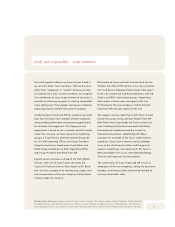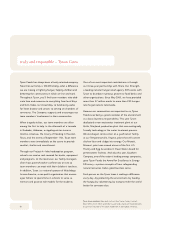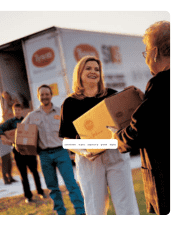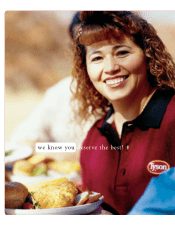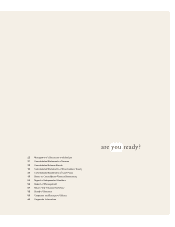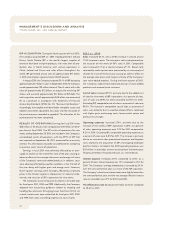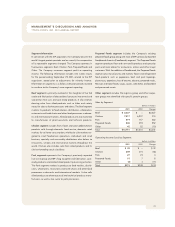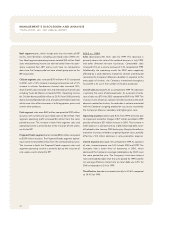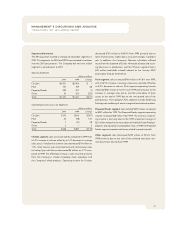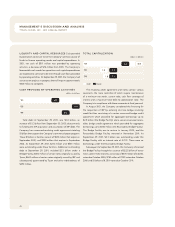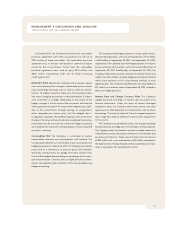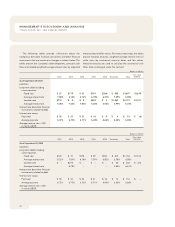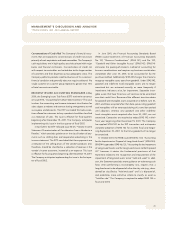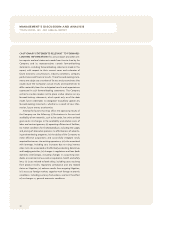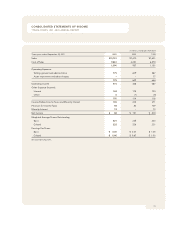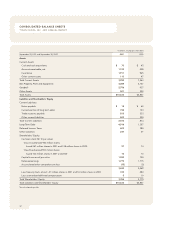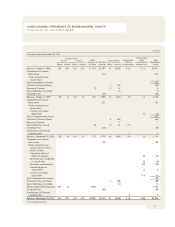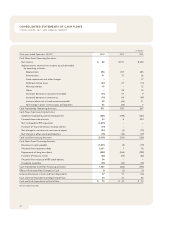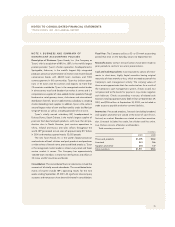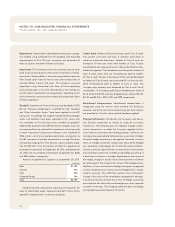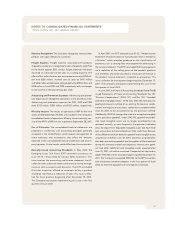Tyson Foods 2001 Annual Report Download - page 29
Download and view the complete annual report
Please find page 29 of the 2001 Tyson Foods annual report below. You can navigate through the pages in the report by either clicking on the pages listed below, or by using the keyword search tool below to find specific information within the annual report.
27
MANAGEMENT
’S DISCUSSION AND ANALYSIS
TYSON FOODS, INC. 2001 ANNUAL REPORT
In October 2001, the Company entered into a receivables
purchase agreement with three co-purchasers to sell up to
$750 million of trade receivables. The receivables purchase
agreement has an interest rate based on commercial paper
issued by the co-purchasers. Funds from the receivables
purchase agreement were used to repay $210 million and
$500 million outstanding under the $1 billion revolving
credit agreements.
MARKET RISK Market risks relating to the Company’s opera-
tions result primarily from changes in commodity prices, interest
rates and foreign exchange rates as well as credit risk concen-
trations. To address certain of these risks, the Company enters
into various hedging transactions as described below. If a deriv-
ative instrument is a hedge, depending on the nature of the
hedge, changes in the fair value of the instrument will either be
offset against the change in fair value of the hedged assets, liabil-
ities, or firm commitments through earnings, or recognized in
other comprehensive income (loss) until the hedged item is
recognized in earnings. The ineffective portion of an instrument’s
change in fair value will be immediately recognized in earnings.
Instruments that do not meet the criteria for hedge accounting
are marked to fair value with unrealized gains or losses reported
currently in earnings.
Commodities Risk The Company is a purchaser of certain
commodities, primarily corn and soybeans, and livestock. The
Company periodically uses commodity futures and options for
hedging purposes to reduce the effect of changing commodity
prices and as a mechanism to procure grains and livestock.
Generally, contract terms of a hedge instrument closely mirror
those of the hedged item providing a high degree of risk reduc-
tion and correlation. Contracts that are highly effective at meet-
ing this risk reduction and correlation criteria are recorded using
hedge accounting.
The Company held hedge positions in various grain futures,
primarily long positions, with net unrealized losses of $1 million
and $9 million at September 29, 2001, and September 30, 2000,
respectively. The Company also held hedge positions in livestock
futures, primarily short positions, with a fair value of $4 million at
September 29, 2001. Additionally, at September 29, 2001, the
Company held certain positions, primarily in livestock futures and
options, for which it does not apply hedge accounting, but instead
marks these positions to fair value through earnings at each
reporting date. The Company had reflected a fair value liability of
$11 million on its balance sheet at September 29, 2001, related to
these non-hedge positions.
Interest Rate and Foreign Currency Risks The Company
hedges exposure to changes in interest rates on certain of its
financial instruments. Under the terms of various leveraged
equipment loans, the Company enters into interest rate swap
agreements to effectively lock in a fixed interest rate for these
borrowings. The maturity dates of these leveraged equipment
loans range from 2005 to 2008 with interest rates ranging from
4.7% to 6.0%.
The Company also periodically enters into foreign exchange
forward contracts to hedge some of its foreign currency exposure.
The Company enters into forward contracts to hedge exposure to
United States currency fluctuations inherent in its receivables and
purchase commitments. These contracts had a notional amount
of $94 million and a net unrealized loss of $1 million recorded on
the balance sheet. Foreign forward contracts generally have matu-
rities or expirations not exceeding 12 months.


